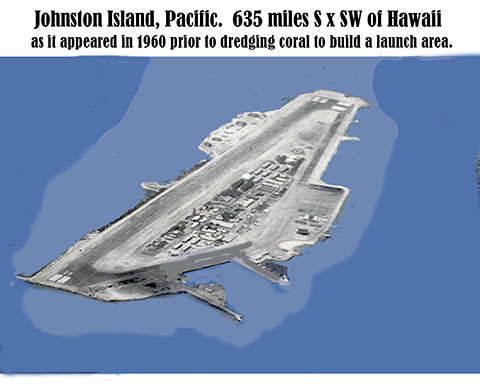Space Cover 617: Johnston Island Nuclear Bomb LaunchesFebruary 1961
Johnston Island is a small atoll in the Pacific Ocean, 635 miles southwest of Hawaii. I was sent there on Temporary Duty (TDY) for 38 days as the U.S. government was dredging coral to build a rocket launch pad, increasing the size of the island from 220 acres to 600 acres. We did not know why this was being done at that time, but we were told several times that Russian "fishing trawlers" were a few miles offshore, and keeping watch on what was going on.
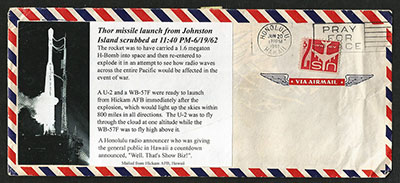 June 19, 1961
June 19, 1961A secret program called "Starfish" was revealed to be a rocket, carrying a hydrogen bomb into outer space. On this date, the Thor rocket was launched. This first Starfish launch began breaking apart 59 seconds into the launch at 4:40 p.m. An operator destructed the missile at 35,000 feet showering the island and surrounding waters with plutonium contaminated fragments. Nothing was seen from this event in Hawaii; however aircraft from Hickam Air Force Base in Hawaii flew to check radiation levels, returning on June 19th.
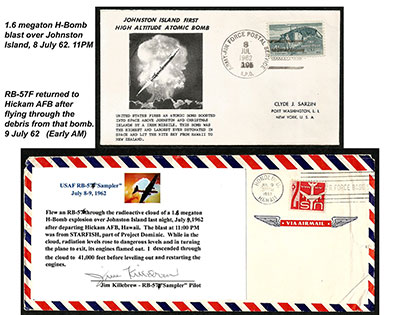
July 8, 1962
A Thor missile launched a 1.6 megaton Hydrogen bomb into space at 22:45 hours. At 23:00 hours it re-entered the Earth's atmosphere and exploded 250 miles up. The light from the explosion lit up the sky for eight hundred miles in all directions and was seen from Hawaii to New Zealand for up to six minutes.
Radiation from this July launch damaged or destroyed eight of the 24 satellites which were in or later launched into orbit, as the radiation rose up to where they were orbiting. Among those were Telstar 1 and later the radiation destroyed radiation scouts Explorers 14 and 15 which were launched the following October.
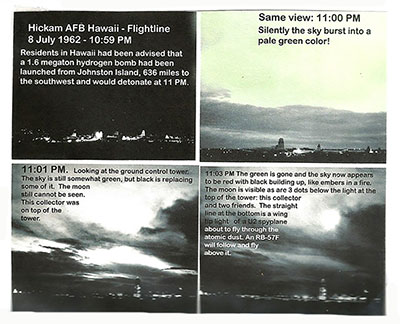
July 9, 1962
In the third and fourth photos of this quartet of images, the camera was aimed at the ground control tower. In the 8X10 photo, there are images of three people on top of that tower. I was one of them. No planes had left or landed at the flightline shared by the City of Honolulu and Hickam AFB. That is why the movements below me of wingtip lights grabbed my attention, just before the silent blast ignited the sky with a strange green color, as if someone had flipped a light switch.
The lights were on a U-2 aircraft which was painted white on the top half and black on the bottom. It was one of two aircraft that entered the area below the explosion at 40,000 feet. By a freak coincidence, I met the pilot of the RB-57F "Sniffer" that flew through the debris far above the U2. The pilot told me, and signed the paper affixed to this cover, that when the RB-57 flew into the cloud debris, his radiation detector went wild. He made a sharp turn and his engine shut down. He smiled as he told me, "So I waited until I dropped down to 41,000 feet and re-lit the engine."
He returned to Hickam sometime after midnight on July 9th. The rumble of the explosion shook my bed an hour and five minutes after the blast occurred. It was about five minutes after the launch that we could clearly discern the moon as the green slowly disappeared and what looked like glowing red embers in a black sky continued to light up the sky above us. It was very, very eerie.
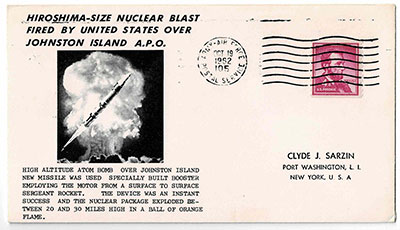
October 19, 1962
An Mk4 re-entry vehicle containing a Hiroshima sized nuclear warhead was launched and exploded. The blast was seen from Hawaii as being similar to a lightning strike from 20 miles away. Airmen were on top of every barracks in our area hoping to see a blast similar to the one on July 8th. It was a letdown for all of us. It was so tiny by comparison! We figured that the 1.6 meg H-bomb could have destroyed a couple of the Hawaiian islands entirely.











